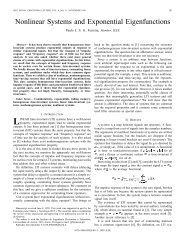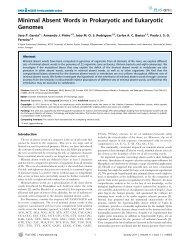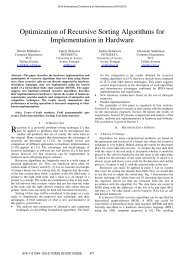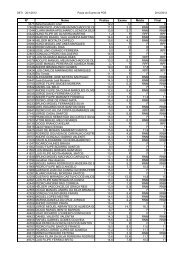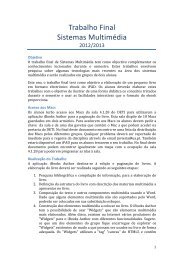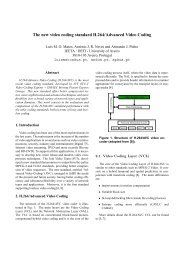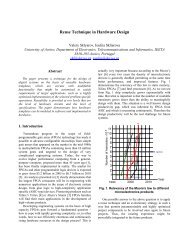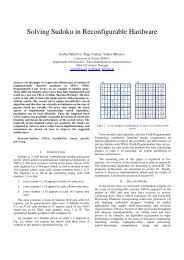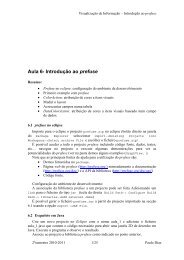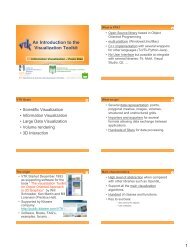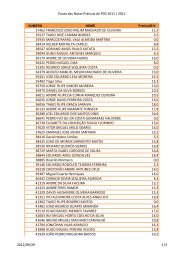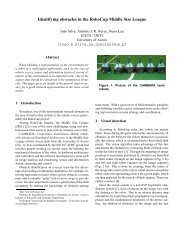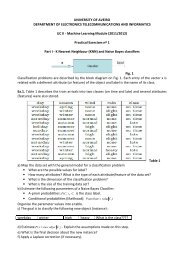DATA SHEET - IEETA
DATA SHEET - IEETA
DATA SHEET - IEETA
You also want an ePaper? Increase the reach of your titles
YUMPU automatically turns print PDFs into web optimized ePapers that Google loves.
Philips Semiconductors Product specification<br />
8-bit microcontroller with on-chip CAN P8xC592<br />
13.6.7.4 Error Signalling<br />
A CAN-controller which detects an error condition,<br />
transmits an Error Flag. Whenever a Bit Error, Stuff Error,<br />
Form Error or an Acknowledgement Error is detected,<br />
transmission of an Error Flag is started at the next bit.<br />
Whenever a CRC Error is detected, transmission of an<br />
Error Flag starts at the bit following the Acknowledge<br />
Delimiter, unless an Error Flag for another error condition<br />
has already started. An Error Flag violates the bit-stuffing<br />
law or corrupts the fixed form bit fields. A violation of the<br />
bit-stuffing law affects any CAN-controller which detects<br />
the error condition. These devices will also transmit an<br />
Error Flag.<br />
An error-passive CAN-controller (see Section 13.6.9)<br />
which detects an error condition, transmits a Passive Error<br />
Flag. A Passive Error Flag is not able to interrupt a current<br />
message at different CAN-controllers but this type of Error<br />
Flag may be ignored (overwritten) by other<br />
CAN-controllers. After having detected an error condition,<br />
an error-passive CAN-controller will wait for six<br />
consecutive bits with identical polarity and when<br />
monitoring them, interpret them as an Error Flag.<br />
After transmission of an Error Flag, each CAN-controller<br />
monitors the bus-line until it detects a transition from a<br />
dominant-to-recessive bit level. At this point in time, every<br />
CAN-controller has finished transmitting its Error Flag and<br />
all CAN-controllers start transmitting seven additional<br />
recessive bits (Error Delimiter, see Section 13.6.4).<br />
The message format of a Data Frame or Remote Frame is<br />
defined in such a way that all detectable errors can be<br />
signalled within the message transmission time and<br />
therefore it is very simple for the CAN-controllers to<br />
associate an Error Frame to the corresponding message<br />
and to initiate retransmission of the corrupted message. If<br />
a CAN-controller monitors any deviation of the fixed form<br />
of an Error Frame, it transmits a new Error Frame.<br />
13.6.7.5 Overload Signalling<br />
Some CAN-controllers (but not the one on-chip of the<br />
P8xC592) require to delay the transmission of the next<br />
Data Frame or Remote Frame by transmitting one or more<br />
Overload Frames. The transmission of an Overload Frame<br />
must start during the first bit of an expected Intermission<br />
Field. Transmission of Overload Frames which are<br />
reactions on a dominant bit during an expected<br />
Intermission Field, start one bit after this event.<br />
Though the format of Overload Frame and Error Frame are<br />
identical, they are treated differently. Transmission of an<br />
Overload Frame during Intermission Field does not initiate<br />
1996 Jun 27 60<br />
the retransmission of any previous Data Frame or Remote<br />
Frame. If a CAN-controller which transmitted an Overload<br />
Frame monitors any deviation of its fixed form, it transmits<br />
an Error Frame.<br />
13.6.8 ERROR DETECTION<br />
The processes described in Sections 13.6.8.1 to 13.6.10.3<br />
are implemented in the P8xC592's on-chip CAN-controller<br />
for error detection.<br />
13.6.8.1 Bit Error<br />
A transmitting CAN-controller monitors the bus on a<br />
bit-by-bit basis. If the bit level monitored is different from<br />
the transmitted one, a Bit Error is signalled.<br />
The exceptions being:<br />
• During the Arbitration Field, a recessive bit can be<br />
overwritten by a dominant bit. In this case, the<br />
CAN-controller interprets this as a loss of arbitration.<br />
• During the Acknowledge Slot, only the receiving<br />
CAN-controllers are able to recognize a Bit Error.<br />
13.6.8.2 Stuff Error<br />
The following bit fields are coded using the bit-stuffing<br />
technique:<br />
• Start-Of-Frame<br />
• Arbitration Field<br />
• Control Field<br />
• Data Field<br />
• CRC Sequence.<br />
There are two possible ways of generating a Stuff Error:<br />
• A disturbance generates more than the allowed five<br />
consecutive bits with identical polarity. These errors are<br />
detected by all CAN-controllers.<br />
• A disturbance falsifies one or more of the five bits<br />
preceding the stuff bit. This error situation is not<br />
recognized as a Stuff Error by the receivers. Therefore,<br />
other error detection processes may detect this error<br />
condition such as:<br />
– CRC check, format violation at the receiving<br />
CAN-controllers, or<br />
– Bit Error detection by the transmitting CAN-controller.



